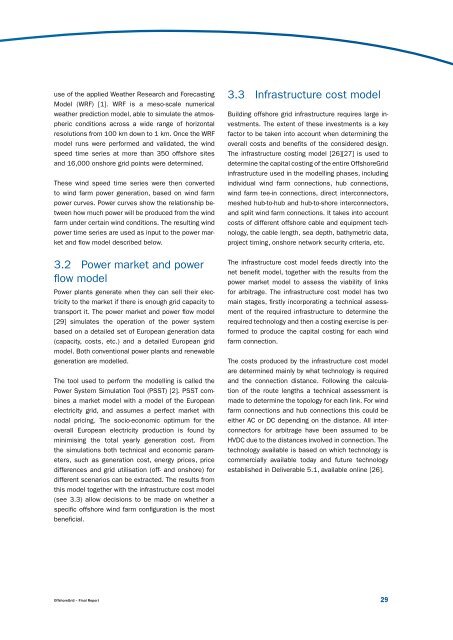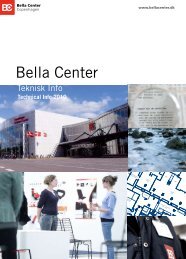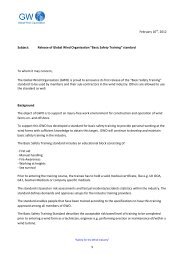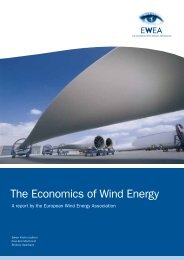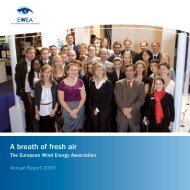Offshore Electricity Infrastructure in Europe - European Wind Energy ...
Offshore Electricity Infrastructure in Europe - European Wind Energy ...
Offshore Electricity Infrastructure in Europe - European Wind Energy ...
Create successful ePaper yourself
Turn your PDF publications into a flip-book with our unique Google optimized e-Paper software.
use of the applied Weather Research and Forecast<strong>in</strong>g<br />
Model (WRF) [1]. WRF is a meso-scale numerical<br />
weather prediction model, able to simulate the atmospheric<br />
conditions across a wide range of horizontal<br />
resolutions from 100 km down to 1 km. Once the WRF<br />
model runs were performed and validated, the w<strong>in</strong>d<br />
speed time series at more than 350 offshore sites<br />
and 16,000 onshore grid po<strong>in</strong>ts were determ<strong>in</strong>ed.<br />
These w<strong>in</strong>d speed time series were then converted<br />
to w<strong>in</strong>d farm power generation, based on w<strong>in</strong>d farm<br />
power curves. Power curves show the relationship between<br />
how much power will be produced from the w<strong>in</strong>d<br />
farm under certa<strong>in</strong> w<strong>in</strong>d conditions. The result<strong>in</strong>g w<strong>in</strong>d<br />
power time series are used as <strong>in</strong>put to the power market<br />
and flow model described below.<br />
3.2 Power market and power<br />
flow model<br />
Power plants generate when they can sell their electricity<br />
to the market if there is enough grid capacity to<br />
transport it. The power market and power flow model<br />
[29] simulates the operation of the power system<br />
based on a detailed set of <strong>Europe</strong>an generation data<br />
(capacity, costs, etc.) and a detailed <strong>Europe</strong>an grid<br />
model. Both conventional power plants and renewable<br />
generation are modelled.<br />
The tool used to perform the modell<strong>in</strong>g is called the<br />
Power System Simulation Tool (PSST) [2]. PSST comb<strong>in</strong>es<br />
a market model with a model of the <strong>Europe</strong>an<br />
electricity grid, and assumes a perfect market with<br />
nodal pric<strong>in</strong>g. The socio-economic optimum for the<br />
overall <strong>Europe</strong>an electricity production is found by<br />
m<strong>in</strong>imis<strong>in</strong>g the total yearly generation cost. From<br />
the simulations both technical and economic parameters,<br />
such as generation cost, energy prices, price<br />
differences and grid utilisation (off- and onshore) for<br />
different scenarios can be extracted. The results from<br />
this model together with the <strong>in</strong>frastructure cost model<br />
(see 3.3) allow decisions to be made on whether a<br />
specific offshore w<strong>in</strong>d farm configuration is the most<br />
beneficial.<br />
<strong>Offshore</strong>Grid – F<strong>in</strong>al Report<br />
3.3 <strong>Infrastructure</strong> cost model<br />
Build<strong>in</strong>g offshore grid <strong>in</strong>frastructure requires large <strong>in</strong>vestments.<br />
The extent of these <strong>in</strong>vestments is a key<br />
factor to be taken <strong>in</strong>to account when determ<strong>in</strong><strong>in</strong>g the<br />
overall costs and benefits of the considered design.<br />
The <strong>in</strong>frastructure cost<strong>in</strong>g model [26][27] is used to<br />
determ<strong>in</strong>e the capital cost<strong>in</strong>g of the entire <strong>Offshore</strong>Grid<br />
<strong>in</strong>frastructure used <strong>in</strong> the modell<strong>in</strong>g phases, <strong>in</strong>clud<strong>in</strong>g<br />
<strong>in</strong>dividual w<strong>in</strong>d farm connections, hub connections,<br />
w<strong>in</strong>d farm tee-<strong>in</strong> connections, direct <strong>in</strong>terconnectors,<br />
meshed hub-to-hub and hub-to-shore <strong>in</strong>terconnectors,<br />
and split w<strong>in</strong>d farm connections. It takes <strong>in</strong>to account<br />
costs of different offshore cable and equipment technology,<br />
the cable length, sea depth, bathymetric data,<br />
project tim<strong>in</strong>g, onshore network security criteria, etc.<br />
The <strong>in</strong>frastructure cost model feeds directly <strong>in</strong>to the<br />
net benefit model, together with the results from the<br />
power market model to assess the viability of l<strong>in</strong>ks<br />
for arbitrage. The <strong>in</strong>frastructure cost model has two<br />
ma<strong>in</strong> stages, firstly <strong>in</strong>corporat<strong>in</strong>g a technical assessment<br />
of the required <strong>in</strong>frastructure to determ<strong>in</strong>e the<br />
required technology and then a cost<strong>in</strong>g exercise is performed<br />
to produce the capital cost<strong>in</strong>g for each w<strong>in</strong>d<br />
farm connection.<br />
The costs produced by the <strong>in</strong>frastructure cost model<br />
are determ<strong>in</strong>ed ma<strong>in</strong>ly by what technology is required<br />
and the connection distance. Follow<strong>in</strong>g the calculation<br />
of the route lengths a technical assessment is<br />
made to determ<strong>in</strong>e the topology for each l<strong>in</strong>k. For w<strong>in</strong>d<br />
farm connections and hub connections this could be<br />
either AC or DC depend<strong>in</strong>g on the distance. All <strong>in</strong>terconnectors<br />
for arbitrage have been assumed to be<br />
HVDC due to the distances <strong>in</strong>volved <strong>in</strong> connection. The<br />
technology available is based on which technology is<br />
commercially available today and future technology<br />
established <strong>in</strong> Deliverable 5.1, available onl<strong>in</strong>e [26].<br />
29


